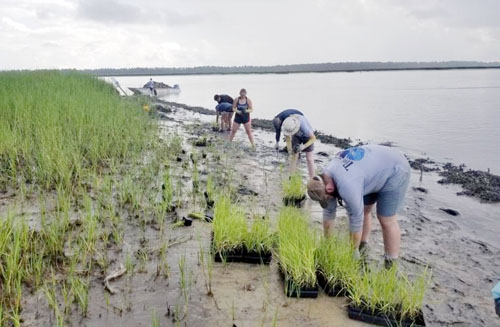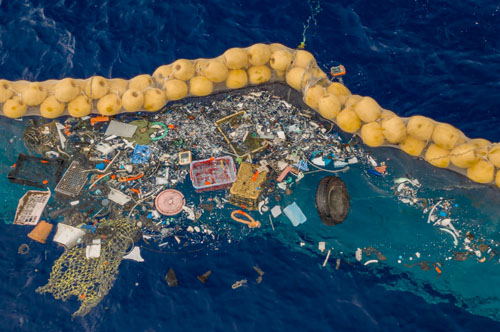 | | |  As the beach crowds start to dwindle with the arrival of September, a sense of calm returns to our coasts. The air carries a cooler breeze (much welcome after this summer’s intense heat waves), hinting at the changing seasons, but the work to protect our oceans is far from slowing down. I hope that with the school year beginning again – a hectic time for the entire family – you can take a moment to reconnect with the serenity of the ocean and appreciate the beauty of marine life. This month’s RCC Coasts and Ocean Observer issue brings with it critical milestones, from groundbreaking federal policy initiatives aimed at marine debris removal to grassroots coastal restoration efforts. As the beach crowds start to dwindle with the arrival of September, a sense of calm returns to our coasts. The air carries a cooler breeze (much welcome after this summer’s intense heat waves), hinting at the changing seasons, but the work to protect our oceans is far from slowing down. I hope that with the school year beginning again – a hectic time for the entire family – you can take a moment to reconnect with the serenity of the ocean and appreciate the beauty of marine life. This month’s RCC Coasts and Ocean Observer issue brings with it critical milestones, from groundbreaking federal policy initiatives aimed at marine debris removal to grassroots coastal restoration efforts. Diving deeper – pun intended – into recent policy initiatives, the Biden-Harris administration’s recent $23 million investment in marine debris removal is a critical step toward cleaner, safer waters. Meanwhile, NOAA’s progress on the Chumash Heritage National Marine Sanctuary brings the West Coast closer to securing one of its most culturally and ecologically significant marine areas.  On the conservation front, researchers are shedding new light on marine biodiversity and the importance of protecting our ecosystems. Updated seashell field guides in North Carolina and innovative student-led ocean mapping projects from New Jersey signal an exciting blend of tradition and technology in marine research. In Florida, encouraging signs of recovery are emerging for coral reefs previously affected by bleaching. Ongoing restoration efforts are showing promise, with researchers noting improved coral health and growth rates, highlighting the resilience of these vital ecosystems when supported by effective conservation strategies. You can read more on the effects of coral bleaching in the recent blog post by my colleague, RCC Stanback Fellow Emely Arredondo: Surfing and Corals: Does Coral Bleaching Matter? On the conservation front, researchers are shedding new light on marine biodiversity and the importance of protecting our ecosystems. Updated seashell field guides in North Carolina and innovative student-led ocean mapping projects from New Jersey signal an exciting blend of tradition and technology in marine research. In Florida, encouraging signs of recovery are emerging for coral reefs previously affected by bleaching. Ongoing restoration efforts are showing promise, with researchers noting improved coral health and growth rates, highlighting the resilience of these vital ecosystems when supported by effective conservation strategies. You can read more on the effects of coral bleaching in the recent blog post by my colleague, RCC Stanback Fellow Emely Arredondo: Surfing and Corals: Does Coral Bleaching Matter?  At the same time, scientists are studying the vital roles of sharks and lobsters in maintaining healthy oceans, even as their habitats face the challenges of pollution and climate change. However, pollution (particularly plastic) remains a pressing concern. From ambitious clean-up efforts targeting the Great Pacific Garbage Patch to localized actions like plastic bag bans, communities and governments are stepping up to tackle this global crisis. At the same time, scientists are studying the vital roles of sharks and lobsters in maintaining healthy oceans, even as their habitats face the challenges of pollution and climate change. However, pollution (particularly plastic) remains a pressing concern. From ambitious clean-up efforts targeting the Great Pacific Garbage Patch to localized actions like plastic bag bans, communities and governments are stepping up to tackle this global crisis.
Finally, stories of resilience – both human and environmental – remind us of the power of collective action. Whether it’s restoring manatee populations in Florida or safeguarding surf breaks to mitigate climate change, every action we take is a small but vital wave in the larger ocean of sustainability. In this issue, we explore these stories and more, highlighting the tireless work of individuals, institutions, and communities dedicated to protecting our oceans. | | | | | | | |  RCC Presidential Fellow – Jack Sanitate RCC Presidential Fellow – Jack Sanitate
RCC Presidential Fellow, Jack serves as the co-lead of the RCC Coasts and Ocean program with Bob Musil and editor of the RCC Coasts and Ocean Observer. | | | | | | Biden-Harris Administration Invests More Than $23 Million to Remove Marine Debris Bipartisan Infrastructure Law funding will support 13 new removal and interception projects. Today, the Department of Commerce and NOAA recommended more than $23 million in funding to support marine debris removal and interception efforts for 13 multi-year projects across 10 coastal U.S. states, three territories and the District of Columbia. | | | | | | | | NOAA Reaches Key Milestone in Designation of Chumash Heritage National Marine Sanctuary Agency releases final environmental impact statement for West Coast sanctuary The designation process for the proposed Chumash Heritage National Marine Sanctuary took a major step forward today as NOAA announced the release of the final environmental impact statement (FEIS), which outlines the environmental impacts of the proposed sanctuary and is a necessary step toward this final designation. | | | | | | | | Conchologists Expand, Revise Popular Seashell Field Guide North Carolina Sea Grant has revised and expanded its “Seashells of North Carolina,” a long-trusted guide to help everyone from beachcombers to graduate students identify the treasures they find along the Tar Heel State’s beaches. The late Hugh Porter, who was referred to as “Mr. Seashell” during his nearly 55-year career at the University of North Carolina Institute of Marine Sciences in Morehead City, and Lynn Houser wrote the guide that was originally released in 1997. | | | | | | | | N.J. College Sends Students on a Cruise to Map the Bottom of the Atlantic Ocean A nationwide search for college students for an inaugural series of cruises with the National Oceanic and Atmospheric Administration included six from Stockton University in New Jersey. Stockton was one of only six schools in the country invited by NOAA to send students, the university said. They lived and worked with the crew last month as it mapped the Atlantic Ocean floor 1,500 feet below on an 186-foot research vessel off the coast of South Carolina. | | | | | | | | Duke’s Marine Lab: At the Frontlines of Climate Change and Ocean Sciences Some learning just requires you to get salty, wet and muddy. Two hundred miles from Duke’s campus, the Duke Marine Lab in Beaufort is an unusual learning environment where Duke students and researchers are addressing questions of ocean and marine science that affect us all. Learn more about the lab’s work and its partnership with the coastal community in a new documentary that will debut online at noon, Monday, Sept. 9. | | | | | | | | Oceans Without Sharks Would Be Far Less Healthy – New Research There are more than 500 species of sharks in the world’s oceans, from the 7-inch dwarf lantern shark to whale sharks that can grow to over 35 feet long. They’re found from polar waters to the equator, at the water’s surface and miles deep, in the open ocean, along coasts and even in some coastal rivers. With such diversity, it’s no surprise that sharks serve many ecological functions. | | | | | | | | Sizzling Success: New England Hot Sauce Fest Raises Thousands For Ocean Conservation With sunny skies and a vibrant crowd, the 3rd annual New England Hot Sauce Fest, presented by The Spicy Shark, sizzled with excitement on Saturday, July 27, at Smuttynose Brewery in Hampton. The festival raised $17,942 for two Seacoast organizations dedicated to preserving ocean ecosystems. Attendees flocked to Smuttynose Brewery, where over 35 hot sauce companies showcased their spiciest creations, while festivalgoers enjoyed a wide variety of culinary offerings and family-friendly activities. | | | | | | | | Florida’s Coral Reefs Are Still Ailing But Doing Better A year after the worst bleaching event ever recorded, the coral reefs off the Florida coast are slowly recovering. Despite elevated ocean temperatures, scientists say this summer they didn’t see significant bleaching. Corals expel their algae when the water is too hot for too long of a period. Last summer, record ocean temperatures fueled by an El Niño climate pattern sparked a global coral bleaching event. In the Florida Keys, there was widespread bleaching and many corals died, decimating reefs. | | | | | | | | | | New Manatee Rehabilitation Center Opens at Clearwater Marine Aquarium Injured and sick manatees have a new place to get better. A manatee rehabilitation center is now open at the Clearwater Marine Aquarium. Clearwater Marine Aquarium was already famous for Hope and Winter - who starred in the "Dolphin Tales" movies. Now, Yeti and Zamboni are the newest residents here. They were rescued for cold shock in February and treated at ZooTampa. Now, they're being cared for in a new tank that has a bottom that can lift them out of the pool for treatment. | | | | | | | | The World is Pumping Out 57 Million Tons of Plastic Pollution a Year The world creates 57 million tons of plastic pollution every year and spreads it from the deepest oceans to the highest mountaintop to the inside of people’s bodies, according to a new study that also said more than two-thirds of it comes from the Global South. It’s enough pollution each year — about 52 million metric tons — to fill New York City’s Central Park with plastic waste as high as the Empire State Building, according to researchers at the University of Leeds in the United Kingdom. | | | | | | | | Ships Sent to Clean Great Pacific Garbage Patch in Middle of Ocean Return to SF Floating in the middle of the ocean is a giant collection of trash and debris that's come to be known as the Great Pacific Garbage Patch. The accumulation of plastics, cans and other waste has become one of the most prominent examples of the environmental crisis engulfing the planet -- threatening not just marine life, but also humans. | | | | | | | | Plastic Bag Bans Have Drastically Reduced Ocean Pollution As humans, we often find ourselves navigating through the concrete jungles of our cities, an ecosystem teeming with life and, sadly, litter. Among the cans, wrappers, and discarded masks, one particular item stands out, swirling in the urban breeze or ensnared in the skeletal grip of a leafless tree – the ubiquitous plastic bag, now banned in many states. | | | | | | | | Vessel Turn-in Program Prevents Marine Pollution Boats that fall into disrepair pose threats to fish, shellfish and the broader marine ecosystem. That’s especially true of derelict vessels that have broken away from their mooring or are otherwise stranded in places where they shouldn’t be. Derelict vessels may spill or leak fuel into the water, as well as expel other chemicals over time as the structure deteriorates. | | | | | | | | Injured Waters What disability taught me about aquifers. IN 2017, I arrived in Tucson, Arizona, to research an aquifer that weapons manufacturers had polluted decades before. My own disability, and the illnesses and disabilities of thousands of others, were likely caused by this pollution. Yet my feelings toward this aquifer were never of fear or anger, but of solidarity. After all, the aquifer too was injured. Disability led me to want to get to know this aquifer—to understand more deeply what aquifers are and what they do. I had a lot to learn. | | | | | | | | Protecting Surf Breaks Mitigates Climate Change, Helps Coastal Communities, Analysis Finds Safeguarding places to hang ten and shoot the curl is an opportunity to simultaneously mitigate climate change, fuel tourism and help surrounding ecosystems, new research has shown. “There is a growing conservation movement regarding coastal areas that host surf breaks,” said Jacob Bukoski of Oregon State University, one of the study’s co-authors. | | | | | | | | E. Boston Resilience Effort Puts Shoreline Future in the Hands of Local Youth At an old, unused industrial site along the East Boston harbor, a new local effort is engaging local students to explore ways to make the shoreline more resilient. What was once an unused beach area and former site of a shipbuilding yard now is the home of curving, swirling bundles of cut reeds, each structure planted with grasses local to New England salt marshes and anchored along the beach to create a barrier against increased storm waves. | | | | | | | | Boating Fleets Empower Entergy Crews to Restore Coastal Communities Hurricane Francine made landfall in Terrebonne Parish as a Category 2 hurricane on Sept. 11, bringing up to 100 mph winds to the Louisiana coast. The hardest-hit areas in southeast Louisiana present difficult geographic challenges for restoration workers that require unique solutions to turn the lights back on. Entergy crews, contractors and mutual-aid workers are using every available tool to make repairs in and around marshes, rivers and other hard-to-reach locations. | | | | | | | | Project 2025’s Plan To ‘Drill, Baby, Drill’ Threatens Ocean Health and Economic Stability Project 2025’s expansion of offshore drilling threatens ocean health through pollution and oil spills; endangers coastal economies reliant on tourism and fishing; and diverts investment from renewable energy, exacerbating climate change. Project 2025 threatens to unravel decades of conservation and climate progress. This extreme initiative, developed by the Heritage Foundation as a road map for a far-right presidential administration. | | | | | | | | Big Waves Off Oregon Coast Fuel Cutting-edge Effort to Harness the Ocean For Electricity Off the Oregon coast just south of Newport, large rounded swells rocked The Discovery from side to side, the waves nearly tipping the boat sideways. Deep under the wobbling vessel, steel pipes carrying power and data cables stretched for a dozen miles buried along the seafloor, ready to capture the energy of those Pacific Ocean surges, known for their constancy, massive size and predictability. | | | | | | | | Melting Glaciers: Lifeline or Threat For Arctic Fjords and Coasts? Glaciers across the Arctic are melting. Glacial run-off enters fjords and coastal waters, but we know little about its impact on ocean life. Understanding how marine organisms from microbes to mammals respond is critical for sustainable management of coastal ecosystems and the services they provide. Glaciers are intrinsic to the Arctic, covering >2 million km2 of land area above 50°N. | | | | | | | | Climate Change is Making Our Oceans Dangerously Noisy (study reveals why) Ocean noise pollution has long been a concern for marine life, but recent studies suggest that climate change is set to exacerbate this issue. As global temperatures rise, the underwater soundscape is undergoing significant changes, potentially disrupting ecosystems and threatening marine biodiversity. The oceans are becoming increasingly noisy environments, a trend that began with the Industrial Revolution. However, climate change is now amplifying this problem in unexpected ways. | | | | | | | | W&M Study Offers Hope For the Resilience of the American Lobster Fishery According to a study by researchers at William & Mary’s Batten School of Coastal & Marine Sciences, the American lobster may be more resilient to the effects of climate change than expected. For the first time, experiments performed at the Virginia Institute of Marine Science (VIMS) documented how female American lobsters groom their offspring, providing evidence that these behaviors are not significantly impacted by temperature and acidity levels. | | | | | | | | NOAA Fishery Councils Prepare to Adapt to Climate Change Shifts in marine species migration and population concentrations are forcing NOAA Fisheries to rethink its regional administrative maps to reflect the new realities of changing ocean habitats. In guidance released Tuesday, the agency’s Office of Sustainable Fisheries established a framework for when and how regulation of a species should be handed off from one regional fishery management council to another based on shifting species population dynamics. | | | | | | | | The Sep 2024 issue of RCC Coasts and Ocean was produced by Ross Feldner | | | | | |  The Rachel Carson Council Depends on Tax-deductible Gifts From Concerned Individuals Like You. Please Help If You Can. The Rachel Carson Council Depends on Tax-deductible Gifts From Concerned Individuals Like You. Please Help If You Can. | | | | | | | |  Sign Up Here to Receive the RCC E-News and Other RCC Newsletters, Information and Alerts. Sign Up Here to Receive the RCC E-News and Other RCC Newsletters, Information and Alerts. | | | | | | | | | | | |